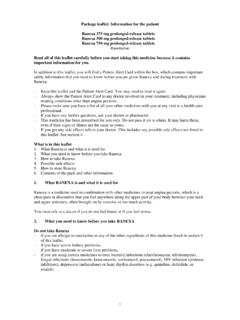Transcription of Actemra solution for subcutaneous injection - …
1 Actemra 170613 1 Consumer Medicine information Actemra solution for subcutaneous injection Tocilizumab 162 mL solution for subcutaneous injection What is in this leaflet This leaflet answers some common questions about Actemra pre-filled syringe for subcutaneous (under the skin) injection . It does not contain all the available information . It does not take the place of talking to your doctor or pharmacist. All medicines have risks and benefits. Your doctor has weighed the risks of you taking Actemra against the benefits they expect it will have for you. If you have any concerns about taking this medicine, ask your doctor or pharmacist. Keep this leaflet. You may need to read it again. What Actemra is used for Actemra contains the active ingredient tocilizumab. Actemra belongs to a group of medicines called anti-rheumatic agents. There are many different classes of anti-rheumatic agents. Actemra belongs to a class called monoclonal antibodies.
2 Monoclonal antibodies are proteins which specifically recognise and bind to other unique proteins in the body. Actemra is used to treat moderate to severe rheumatoid arthritis (RA) in RA, Actemra can also prevent damage occurring to your joints and improve your ability to do your normal daily activities. Actemra is also used to treat giant cell arteritis (GCA). Some of the signs and symptoms of RA and GCA are caused by the actions of a protein called interleukin-6 (IL-6) binding to the interleukin-6 receptor (IL-6R). Actemra works by binding and blocking IL-6R thereby helping to relieve some of the signs and symptoms of RA and GCA. Actemra is approved to treat GCA and RA, however your doctor may have prescribed Actemra for another purpose. Ask your doctor if you have any questions about why Actemra has been prescribed for you. Actemra is not addictive. This medicine is available only with a doctor s prescription. Before you use Actemra When you must not use Actemra Do not use Actemra if: 1.
3 You have had an allergic reaction to Actemra or any ingredients listed at the end of this leaflet Some of the symptoms of an allergic reaction may include shortness of breath, wheezing or difficulty breathing, swelling of the face, lips, tongue or other parts of the body, and rash, itching or hives on the skin. Actemra 170613 2 2. you have had an allergic reaction to any other recombinant human or humanised antibodies or proteins that are of hamster origin 3. you have an active, severe infection 4. the package is torn or shows signs of tampering 5. the expiry date (EXP) printed on the pack has passed. If you take this medicine after the expiry date has passed, it may not work as well. If you are not sure if you should use Actemra , talk to your doctor. Before you use Actemra Tell your doctor if: 1. you have an infection, or a history of a recurring or long-term infection Actemra can reduce your body s ability to respond to infections and may make an existing infection worse or increase the chance of getting a new infection.
4 This is particularly important if you have diabetes or diverticulitis as you may have an increased risk of infection. 2. you have any other health problems, especially the following: liver disease such as viral hepatitis tuberculosis diverticulitis or intestinal ulcers a low white blood cell count or a low platelet count diabetes raised blood pressure high cholesterol or triglycerides kidney disease cancer 3. you are pregnant or plan to become pregnant It is not known whether Actemra is harmful to an unborn baby when taken by a pregnant woman. If there is a need to take Actemra when you are pregnant your doctor will discuss the risks and benefits to you and the unborn baby. 4. you are breast-feeding or plan to breast-feed It is not known whether Actemra passes into breast milk. It is recommended that you stop breast-feeding while you are treated with Actemra . 5. you are planning to have a vaccination or have recently had a vaccination Certain types of vaccines should not be given while using Actemra .
5 6. you are allergic to any other medicines, foods, dyes or preservatives If you have not told your doctor about any of the above, tell them before you start taking Actemra . Use in Children The safety and efficacy of Actemra given as a subcutaneous injection to patients below 18 years of age have not been established. Taking other medicines Tell your doctor if you are taking any other medicines, including any that you have bought from a pharmacy, supermarket or health food shop. Do not use Actemra with other biological medicines used to treat RA, including infliximab, adalimumab, etanercept, anakinra, abatacept, rituximab, certolizumab pegol and golimumab. It is unknown how Actemra interacts with these medicines. Actemra 170613 3 Actemra may interfere with some medicines. These include: warfarin, a medicine used to prevent blood clots cyclosporin, a medicine used after organ transplants atorvastatin and simvastatin, medicines used to reduce cholesterol levels calcium channel blockers, such as amlodipine, which treat raised blood pressure theophylline, a medicine used to treat bronchitis phenytoin, a medicine used to treat epilepsy benzodiazepines, such as diazepam, which treat anxiety omeprazole, a medicine used to treat reflux disease and peptic ulcers dextromethorphan, a cough medicine These medicines may be affected by Actemra , or may affect how well the medicine works.
6 You may need to use different amounts of your medicine, or you may need to take different medicines. Your doctor will advise you. Your doctor or pharmacist has more information on medicines to be careful with or avoid while taking Actemra . Ask your doctor or pharmacist if you are not sure about this list of medicines. How to use Actemra Follow all directions given to you by your doctor or pharmacist carefully. They may differ from the information contained in this leaflet. Use Actemra exactly as your doctor has prescribed. How much to inject The recommended dose of Actemra to treat RA and GCA is 162 mg injected once a week. The syringe is designed to deliver 162 mg per injection when used according to the instructions in this leaflet. Your doctor may test your blood to help guide your treatment. If you experience certain changes in your blood tests, your doctor may decide to interrupt your treatment and reduce the frequency of dosing to 162 mg every 2 weeks or stop your treatment.
7 For RA, Actemra can be used in combination with methotrexate or other arthritis medications. Actemra can also be used on its own if your doctor decides that methotrexate is inappropriate. For GCA, Actemra is initially given in combination with a glucocorticoid medicine (such as prednisone). Over the period of treatment with Actemra , your doctor should reduce the dose of glucocorticoid medicine. How to inject Actemra Actemra is administered by subcutaneous injection . This means it is injected with a short needle into the fatty tissue just under the skin. The first injection of Actemra should always be given under the supervision of your healthcare professional. Your doctor may discuss with you whether it would be more convenient for you to inject Actemra yourself at home, in which case, you or a caregiver would be instructed on how to give the injection . This is a simple procedure and many patients prefer it. Directions for self- injection You should read these directions from beginning to end before starting so that you are familiar with each step of the procedure.
8 These instructions must be carefully followed. Consult with your healthcare provider if you require further instructions. These instructions do not replace the instructions from your healthcare provider. Your healthcare provider should show you how to prepare and inject properly before you inject for the first time. Ask them any questions you may have. Do not attempt to administer an injection until you are sure that you understand how to self-inject. It is important to remain under your doctor s care while using Actemra . Actemra 170613 4 The syringe is for single use only and should be safely discarded after use. How to inject using the syringe The syringe components: Do not use if the syringe appears to be damaged. Do not use if the medicine is cloudy, hazy, discoloured or contains particles. Do not shake the syringe. Do not try to open the syringe or take it apart. Do not remove the needle cap until you are ready to inject. Do not inject through clothing covering the skin.
9 Do not re-use the same syringe. Do not touch the syringe trigger fingers as this may damage the syringe. Gather what you will need: Included in the pack: pre-filled syringe Not included in the pack: Alcohol pad Sterile cotton ball or gauze Puncture-resistant container (also called a sharps container) for safe disposal of the needle cap and used syringe. Find a well-lit, clean, flat surface such as a table. STEP 1. Visually check the syringe Take the carton containing the syringes out of the refrigerator and remove one syringe from the carton. Return the remaining syringes in the carton to the refrigerator. Do not shake. If there is foam in the medicine, put the syringe back in the carton in the refrigerator for use another time and take a new syringe from the refrigerator. Visually examine the syringe, as well as the medicine through the viewing window. Do not use if the syringe appears to be damaged. Do not use if the medicine is cloudy, hazy, discoloured or contains particles.
10 Check the expiration date on the carton and syringe to make sure that it has not expired (Fig. A). The expiry date refers to the last day of that month. Actemra 170613 5 Do not use the syringe if the expiration date has passed. Do not remove the syringe needle cap until step 5. STEP 2. Allow the syringe to adjust to room temperature. Place the syringe on a clean flat surface. Allow the syringe to warm up to room temperature which should take 25 to 30 minutes. Do not warm up the syringe in any other way. STEP 3. Clean your hands Wash your hands with soap and water. Cleanliness is vital during the injection procedure. STEP 4. Choose and prepare an injection site The recommended injection sites are the front and middle of your thighs and the lower part of your abdomen below the navel (belly button), except for the five centimeter area directly around the navel. If a caregiver is giving the injection , the outer area of the upper arms may also be used (Fig.)
















